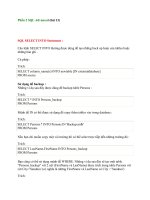Tài liệu Database Systems - Part 5 pptx
Bạn đang xem bản rút gọn của tài liệu. Xem và tải ngay bản đầy đủ của tài liệu tại đây (326.82 KB, 37 trang )
COP 4710: Database Systems (Day 5) Page 1 Mark Llewellyn
COP 4710: Database Systems
Spring 2004
Introduction to Data Modeling – Part 2
BÀI 5, 1 ngày
COP 4710: Database Systems
Spring 2004
Introduction to Data Modeling – Part 2
BÀI 5, 1 ngày
School of Electrical Engineering and Computer Science
University of Central Florida
Instructor : Mark Llewellyn
CC1 211, 823-2790
/>COP 4710: Database Systems (Day 5) Page 2 Mark Llewellyn
•
Some features of a real world situation can be
difficult to model using only the features of the E-R
model that we have seen so far.
•
Some quite common concepts require extending the
E-R model to incorporate mechanisms for modeling
these features. Again, we won’t look at all of them,
but rather an overview of some of the more important
extensions.
Extensions of the E-R Model
COP 4710: Database Systems (Day 5) Page 3 Mark Llewellyn
•
An entity set may include sub-groupings of entities that are
distinct in some way from other entities in the set. For
instance, a subset of entities within an entity set may have
attributes that are not shared by all the entities in the set.
–
As an example, consider the entity set person, with attributes name,
street, and city. A person could further be classified as one of the
following: student or instructor. Each of these person types is
described by a set of attributes that includes all of the attributes of the
entity set person, plus possibly some additional attributes. For
example, student entities may be further described by the attributes
gpa, and credit-hours-earned, whereas, instructor entities are not
characterized by these attributes, but rather a different set such as,
salary, and years-employed.
•
The process of designating sub-groupings within an entity set
is called specialization.
Specialization
COP 4710: Database Systems (Day 5) Page 4 Mark Llewellyn
•
The specialization of person allows us to distinguish among
persons according to whether they are students or instructors.
•
Specialization can be repeatedly applied so that there may be
specializations within specializations.
•
In terms of an E-R diagram, specialization is depicted by a
triangle shaped component which is labeled ISA, which is a
shorthand form of the “is-a” superclass-subclass relationship.
•
The ISA relationship is illustrated in the diagram in the next
slide.
Specialization (cont.)
COP 4710: Database Systems (Day 5) Page 5 Mark Llewellyn
Specialization (cont.)
person
name street city
instructor student
gpa
credit-hours-earned
office
years-
employed
adjunct regular-faculty administrator
course-
listing
salary
sectio
n
phone
ISA
ISA
COP 4710: Database Systems (Day 5) Page 6 Mark Llewellyn
•
The refinement from an initial entity set into successive levels
of entity sub-groupings represents a top-down design
approach in which distinctions are made explicit.
•
This same design process could also proceed in a bottom-up
approach, in which multiple entity sets are synthesized into a
higher-level entity on the basis of common attributes. In other
words, we might have first identified the entity set
students(name, address, city, gpa, credit-hours-earned) and an
entity set instructors(name, address, city, salary, years-
employed).
•
This commonality of attributes is expressed by generalization,
which is a containment relationship that exists between a
higher-level entity set and one or more lower level entity sets.
Generalization
COP 4710: Database Systems (Day 5) Page 7 Mark Llewellyn
•
In our example, person is the higher-level entity set and
instructor and student are the lower-level entity sets.
•
The higher-level entity set represents the superclass and the
lower-level entity represents the subclass. Thus, person is the
superclass of the instructor and student subclasses.
•
For all practical purposes, generalization is just the inverse of
specialization and both processes can be applied (almost
interchangeably) in designing the schema for some real-world
scenario. Notice in the E-R diagram on page 5 that there is no
difference specified between generalization and specialization
other that how you view the picture (reading from the top
down or from the bottom up).
Generalization (cont.)
COP 4710: Database Systems (Day 5) Page 8 Mark Llewellyn
•
Differences in the two approaches are normally characterized
by their starting points and overall goal:
•
Specialization arises from a single entity set; it emphasizes
differences among the entities within the set by creating
distinct lower-level entity sets. These lower-level entity sets
may have attributes or participate in relationships, that do not
apply to all the entities in the higher-level entity set.
•
In fact, the reason that a designer may need to use
specialization is to represent such distinctive features of the
real world scenario.
–
For example, if instructor and student neither have attributes that
person entities do not have nor participate in relationships different
than those in which person entities participate, there would be no
need to specialize the person entity set.
Specialization vs. Generalization
COP 4710: Database Systems (Day 5) Page 9 Mark Llewellyn
•
Generalization arises from the recognition that a number of
entity sets share some common characteristics (namely, they
are described by the same attributes and participate in the
same relationship sets).
•
On the basis of these commonalities, generalization
synthesizes these entity sets into a single, higher-level entity
set.
•
Generalization is used to emphasize the similarities among
lower-level entity sets and to hide the differences. It also
permits an economy of representation in that the shared
attributes are not replicated.
Specialization vs. Generalization (cont.)
COP 4710: Database Systems (Day 5) Page 10 Mark Llewellyn
•
A crucial property of the higher and lower level entities that
are created by specialization and generalization is attribute
inheritance.
•
The attributes of the higher-level entity sets are said to be
inherited by the lower-level entity sets.
–
In our example above, instructor and student both inherit all the
attributes of person (recall that person is the superclass for both
instructor and student).
•
A lower-level entity set (or subclass) also inherits
participation in the relationship sets in which its higher-level
entity set (its superclass) participates.
•
A lower-level entity (subclass) inherits all attributes and
relationships which belong to the higher-level entity set
(superclass) which defines it.
Attribute Inheritance
COP 4710: Database Systems (Day 5) Page 11 Mark Llewellyn
•
Higher-level entity sets do not inherit any attribute or
relationship which is defined within the lower-level entity set.
•
Typically, what is developed will be a hierarchy of entity sets
in which the highest-level entity appears at the top of the
hierarchy.
•
If, in such a hierarchy, a given entity set may be involved as a
lower-level entity set in only one ISA relationship, then the
inheritance is said to be single-inheritance.
•
If, on the other hand, a given entity set is involved as a lower-
level entity set in more than one ISA relationship, then the
inheritance is said to be multiple-inheritance (then the
resulting structure is called a lattice).
Attribute Inheritance (cont.)
COP 4710: Database Systems (Day 5) Page 12 Mark Llewellyn
•
In order to more accurately model a real-world situation, a data
designer may choose to place constraints on a generalization (or
specialization).
•
The first type of constraint involves determining which entities can
be members of a given lower-level entity set. This membership can
be defined in one of the following two ways:
Predicate-defined: In predicate-defined lower-level entity sets,
membership is evaluated on the basis of whether or not an entity
satisfies an explicit predicate (a condition).
–
For example, assume that the higher-level entity set account has the
attribute account-type. All account entities are evaluated on the
defining account-type attribute. Only those entities that satisfy the
predicate account-type = “savings account” would be allowed to
belong to the lower-level entity set savings-account. Since all the
lower-level entities are evaluated on the basis of the same attribute,
this type of generalization is said to be attribute-defined.
Constraints on Generalization
COP 4710: Database Systems (Day 5) Page 13 Mark Llewellyn
User-defined: User-defined lower-level entity sets are not
constrained by a membership condition; rather, the database
user assigns entities to a given entity set.
–
For instance, suppose that after working 3 months at a bank, the
employee is assigned to one of five different work groups. The teams
would be represented as five lower-level entity sets of the higher-
level entity set employee. A given employee is not assigned to a
specific work group automatically on the basis of an explicit defining
condition. Instead, the user responsible for making the group
assignment does so on an individual basis, which may be arbitrary.
Constraints on Generalization (cont.)
COP 4710: Database Systems (Day 5) Page 14 Mark Llewellyn
•
A second type of generalization constraint relates to whether
or not entities may belong to more than one lower-level entity
set within a single generalization. The lower-level entity sets
may be one of the following:
Disjoint: A disjointness constraint requires that an entity belong to
no more than one lower-level entity set. In the example from
above, an account entity can satisfy only one condition for the
account-type attribute at any given time.
–
For example, an account-type might be either a checking account or a
savings account, but it cannot be both.
Constraints on Generalization (cont.)









